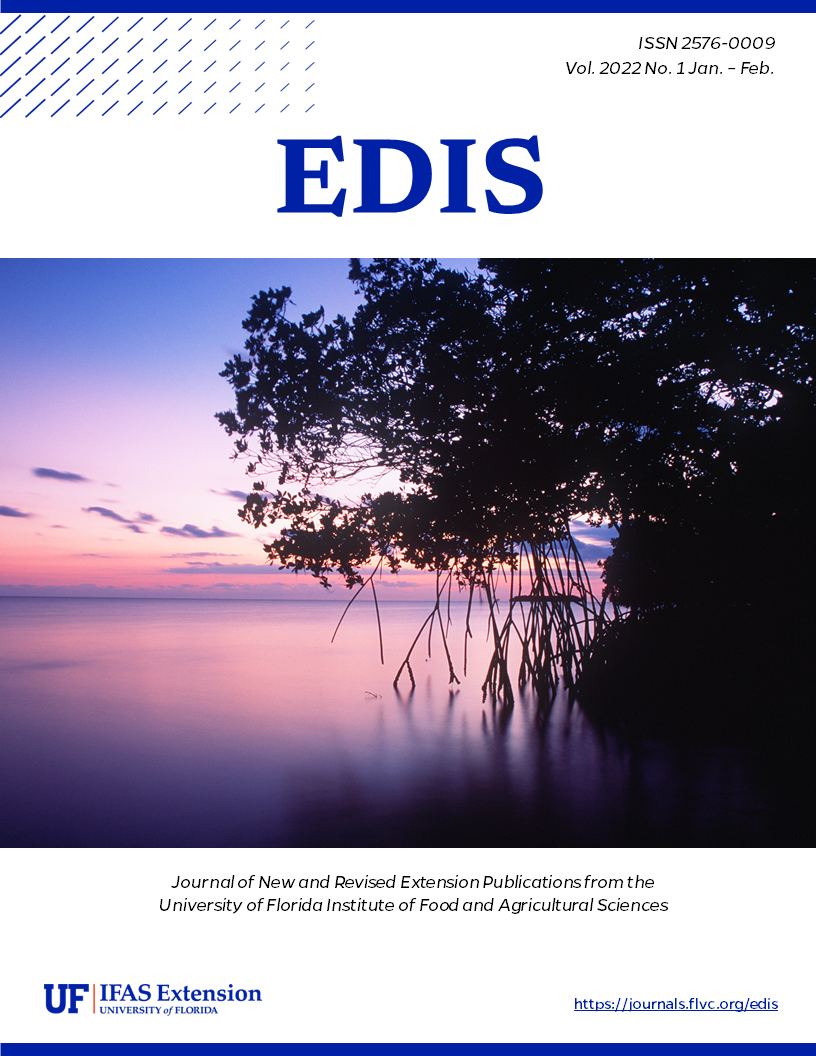Abstract
Waterleaf is a vegetable crop whose edible leaves are soft, succulent, and highly nutritious. It is available in some local grocery stores in Florida but is new to most people in Florida and its environs. Waterleaf production is economically attractive due to low cost for seeds, pesticides, and herbicides for producing the crop. Like other leafy vegetables, waterleaf can be grown in home gardens as well. This new 6-page article will give an overview of this emerging vegetable in Florida. The intended audience is county Extension faculty, students, growers, and consumers. Written by Christianah T. Oladoye and Guodong Liu and published by the UF/IFAS Horticultural Sciences Department.
References
Agunbiade, S. O., M. O. Ojezele, and O. O. Alao. 2015. “Evaluation of the Nutritional, Phytochemical Compositions and Likely Medicinal Benefits of Vernomia amygdalina, Talinum triangulare and Ocimum basilicum Leafy-Vegetables.” Advances in Biological Research 9 (3): 151–155. https://doi.org/10.5829/idosi.abr.2015.9.3.93185
Aja, P. M., A. N. C. Okaka, P. N. Onu, U. Ibiam, and A. J. Urako. 2010. “Phytochemical Composition of Talinum triangulare (Water Leaf) Leaves.” Pakistan Journal of Nutrition 9 (6): 527–530. https://doi.org/10.3923/pjn.2010.527.530
Ajiwe, V. I. E., and C. E. Ejike. 2020. “Talinum triangulare (Waterleaf) Methanol Leaf Extract as Corrosion Inhibitor on Mild Steel Surface in H2SO4.” Colloid and Surface Science 5 (1): 6–12. https://doi.org/10.11648/j.css.20200501.12
Anyalogbu, E. A. A., C. C. Anadi, P. C. Nwweje-Anyalowu, and M. C. Nnoli. 2017. “Use of Waterleaf (Talium triangulare) in Remediation of Soil Exposed to Heavy Metals: A Green Technology Approach.” World Journal of Pharmaceutical and Life Sciences 3 (9): 48–53.
Carolin, R. 1987. “A Review of the Family Portulacaceae.” Australian Journal of Botany 35 (4): 383–412. https://doi.org/10.1071/BT9870383
de Oliveira Amorim, A. P., A. R. de Carvalho Jr., N. P. Lopes, R. N. Castro, M. C. C. de Oliveira, and M. G. de Carvalho. 2014. “Chemical Compounds Isolated from Talinum triangulare.” Food Chemistry 160:204–208. https://doi.org/10.1016/j.foodchem.2014.01.114
Eleazu, C. O., and K. C. Eleazu. 2013. “Bioactive Constituents and In Vitro Antioxidant Capacity of Water Leaf (Talinum triangulare) as Affected by Domestic Cooking.” European Journal of Medicinal Plants 3 (4): 540–551. https://doi.org/10.9734/EJMP/2013/4577
Enete, A. A., and U. E. Okon. 2010. “Economics of Waterleaf (Talinum triangulare) Production in Akwa Ibom State, Nigeria.” Field Actions Science Reports 4:1–5. http://journals.org/factsreports/438
Iren, O. B., E. O. Ayito, P. O. Okon-inyang, and K. I. Ofem. 2017. “Soil Nutrient Status and Yield of Waterleaf (Talinum triangulare Jacq) as Influenced by Rates of Organomineral Fertilizer in a Rainforest Utisol, Nigeria.” International Journal of Applied Research 3 (5): 581–585.
Kristine, B., S. Chien-Chang, and R. Consolacion. 2015. “Chemical Constituents of Talinum triangulare.” Research Journal of Pharmaceutical, Biological and Chemical Sciences 6 (1): 167–171.
Liu, G. D., E. H. Simonne, K. T. Morgan, G. J. Hochmuth, S. Agehara, R. Mylavarapu, and P. B. Williams. 2021. “Chapter 2. Fertilizer Management for Vegetable Production in Florida.” EDIS 2021 (VPH). https://doi.org/10.32473/edis-cv296-2021
Ndukwu, M. C., and S. I. Manuwa. 2015. “Impact of Evaporative Cooling Preservation on the Shelf Life of Fruits and Vegetable in South Western Nigeria.” Res. Agr. Eng. 61 (3): 122–128. https://doi.org/10.17221/54/2013-RAE
Nya, E. J., and M. J. Eka. 2015. “Morphological Characterization and Hybridization of Talinum triangulare Land Races for Desirable Metric Characters in South Eastern Nigeria.” The International Journal of Science and Technoledge 3 (7): 192–197.
Ogunlesi, M., W. Okiei, L. Azeez, V. Obakachi, M. Osunsanmi, and G. Nkenchor. 2010. “Vitamin C Contents of Tropical Vegetables and Foods Determined by Voltammetric and Titrimetric Methods and Their Relevance to the Medicinal Uses of the Plants.” International Journal of Electrochemical Sciences 5:105–115.
Oluwole, F. S., A. O. Falade, and O. O. Ogundipe. 2003. “Anti-inflammatory Effect of Some Common Nigerian Vegetables.” Nig. J. Physiol. Sci. 18 (1): 35–38. https://doi.org/10.4314/njps.v18i1.32616
Orluchukwu, J. A., and C. Poripo. 2014. “Growth and Yield Response to Plant Density of Waterleaf (Talinum triangulare) in Rivers State, Nigeria.” Nigerian Agricultural Journal 45 (1): 31–36.
Sanda, M. E. 2015. “Effects of Waterleaf (Talinum triangulare) Extract on Performance and Immune Response of Broilers Vaccinated with Newcastle Disease Vaccine (LaSota).” International Journal of Food, Agriculture and Veterinary Sciences 5 (2): 60–63.
Satterthwaite, D., G. McGranahan, and C. Tacoli. 2010. “Urbanization and Its Implications for Food and Farming.” Philosophical Transactions of the Royal Society B 365 (1554): 2809–2820. https://doi.org/10.1098/rstb.2010.0136
Schippers, R. R. 2000. “African Indigenous Vegetables, an Overview of the Cultivated Species.” Chatham, UK: Natural Resources Institute/ACP EU Technical Center for Agricultural.
Schippers, R. R. 2004. “Alphabetical Treatment of Vegetables.” In Plant Resources of Tropical Africa 2—Vegetables, edited by G. J. H. Grubben, O. A. Denton, C.-M. Messiaen, R. R. Schippers, R. H. M. J. Lemmens, and L. P. A. Oyen, p. 668. Wageningen, Netherlands: PROTA Foundation.
Stephens, J., and G. D. Liu. 2019. “Soil Preparation and Liming for Vegetable Gardens.” EDIS 2013 (6). https://edis.ifas.ufl.edu/vh024
Swarna, J., T. S. Lokeswari, M. Smita, and R. Ravindhran. 2013. “Characterisation and Determination of In Vitro Antioxidant Potential of Betalains from Talinum triangulare (Jacq) Willd.” Food Chemistry 141 (4): 4382–90. https://doi.org/10.1016/j.foodchem.2013.06.108
USDA, Agricultural Research Service, National Plant Germplasm System. 2022. “Talinum fruticosum (L.) Juss.” Germplasm Resources Information Network (GRIN Taxonomy). National Germplasm Resources Laboratory, Beltsville, Maryland. https://npgsweb.ars-grin.gov/gringlobal/taxonomydetail.aspx?id=402262
USDA Natural Resources Conservation Service. n.d. “Talinum triangulare (Jacq.) Willd. Ceylon Spinach.” https://plants.sc.egov.usda.gov/core/profile?symbol=TATR2
Willie, E. S., and C. C. Eze. 2016. “Effect of Removal of Inflorescence on Fresh Vegetable Yield in Waterleaf [Talinum triangulare (Jacq.) Willd].” Journal of Agriculture and Veterinary Science (IOSR-JAVS) 9 (7): 1–4. https://doi.org/10.9790/2380-0907010104

